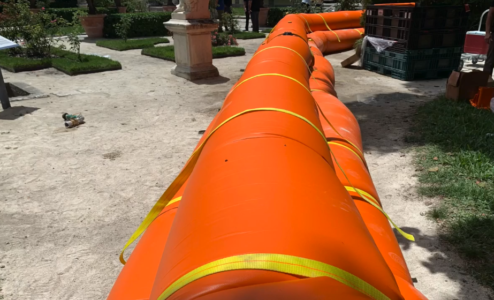FEMA’s new investment

The Tiger Dam System, Courtesy Brizaga
A first of its kind flood prevention system in South Florida has been implemented in an area that has been ground zero in the last few years for some of the worst flooding in the state. Meanwhile, FEMA has announced it is pumping more money into hazard mitigation, as a new UN report says sea level rise is increasing with the rate of rise accelerating.
The historic Vizcaya Museum and Gardens in Miami is now home to the Tiger Dam System, which uses water-filled barriers that can be deployed and anchored to the ground to mitigate flooding. The system, manufactured by U.S. Flood Control, conforms to its surroundings and is flexible to fill gaps that would otherwise allow water intrusion. Storm surge of upwards of five feet from 2017’s Hurricane Irma sent ocean saltwater and debris flooding the main gardens, as well as the café and gift shop at the main house. The project was headed by Brizaga, the Fort Lauderdale civil and coastal engineering company focused on resilience and sea level rise issues. We have great respect and admiration for Brizaga’s principals, one of which is Dr. Alec Bogdanoff. He is a policy-trained oceanographer and meteorologist who appeared on our Florida Insurance Roundup podcast on urban flooding last summer. You can read more and watch a video of the Vizcaya project here.
 FEMA recently announced a significant investment in climate resiliency by authorizing $3.46 billion for the 59 major disaster declarations issued due to the COVID-19 global pandemic. FEMA’s Hazard Mitigation Grant Program will provide funding for states, tribes and territories to maximize their investment in mitigation measures that result in safer and more resilient communities. This new funding will allow communities across the nation to further develop capacity and take mitigation actions that will foster greater resilience and reduce disaster suffering.
FEMA recently announced a significant investment in climate resiliency by authorizing $3.46 billion for the 59 major disaster declarations issued due to the COVID-19 global pandemic. FEMA’s Hazard Mitigation Grant Program will provide funding for states, tribes and territories to maximize their investment in mitigation measures that result in safer and more resilient communities. This new funding will allow communities across the nation to further develop capacity and take mitigation actions that will foster greater resilience and reduce disaster suffering.

Credit: Reimphoto
Also in the news this past week was the United Nation’s updated 4,000-page report from its Intergovernmental Panel on Climate Change. Global mean sea levels, which were increasing by 1.3 mm/year between 1901 and 1971, are now increasing by an estimated 3.7 mm/year, and the rate of rise is accelerating. Sea ice and glaciers are retreating at unprecedented rates, with the frequency and intensity of weather extremes growing. You can read more in this AIR Worldwide analysis. Sea levels in Florida are estimated to rise up to 2.5 feet by 2050 if current trends continue. More than 1 million of Florida’s 6.2 million residential properties are deemed to be at “substantial risk” of non-tidal flooding, according to insurance industry estimates.
LMA Newsletter of 8-23-21

